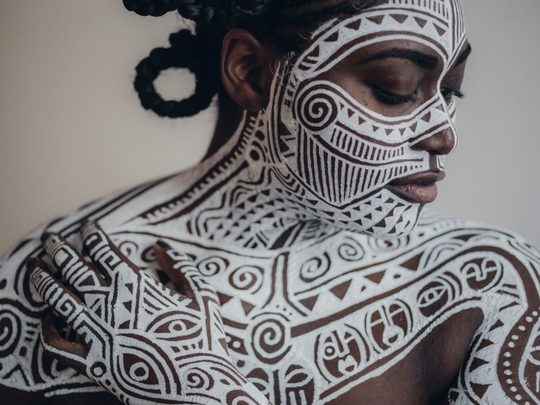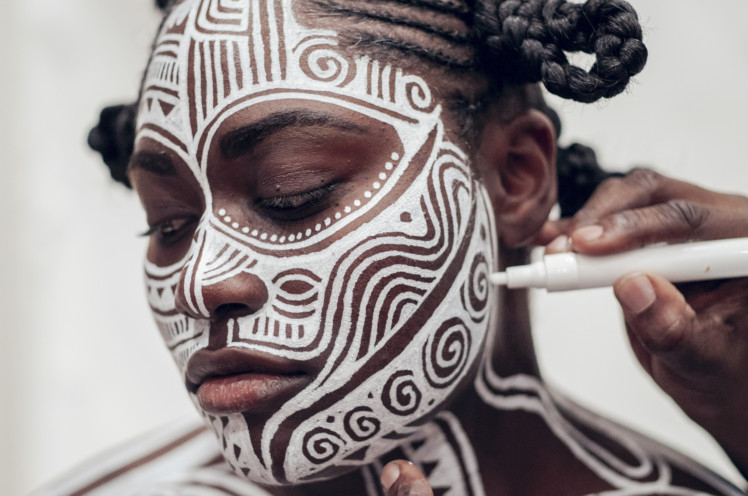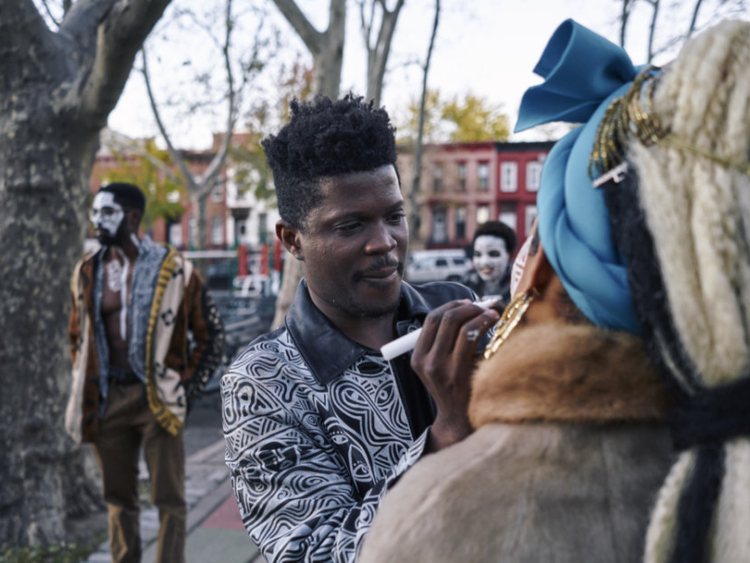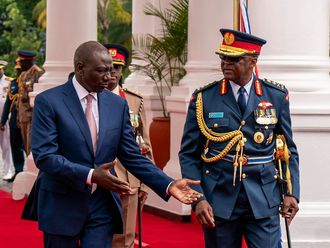
NEW YORK
Laolu Senbanjo stood silently, head slightly bent to one side. Clothing and arms speckled with white paint, he studied his muse a few feet away. With a scratch of his chin and a nod, Senbanjo glided in his socks toward the actress Danielle Brooks. His ever-present white marker in hand, a combination of body paint and other materials, he resumed adorning her face with continuous patterned lines.
“A lot of my work is heavily influenced by the culture of my Yoruba heritage,” said Senbanjo, a Nigerian-born visual artist and musician, in a recent interview at his Brooklyn studio. “I like to see the world in that lens.” His most recognised work, a form of body painting that he calls “the sacred art of the Ori”, draws on those cultural influences and was made famous through its appearance in Beyonce’s Lemonade visual album.
An important aspect of Yoruba culture, Ori means “head” or “essence”, and Senbanjo’s artistic depictions of it have elevated him from Instagram celebrity to appearances at New York art institutions like the Brooklyn Museum and to music festivals such as Afropunk.
“If you tap into your Ori you can move mountains,” Senbanjo said.
Time for art
Drawing from personality traits of deities in Yoruba culture with words as well as patterns, Senbanjo says he conveys various attributes of the deities onto his subjects’ bodies, based on conversations before painting them. The process requires an average of six to eight hours to complete. For Brooks, he created a small crown on her forehead in a nod to royalty, and the idea of beauty and knowing one’s worth.
“For the Yoruba, as well as in several African cultures, the head is the wellspring of wisdom and seat of divine power,” Ugochukwu-Smooth C. Nzewi, curator of African art at the Hood Museum of Art at Dartmouth College, said in an email. With the head also a source for creativity, Nzewi said Senbanjo’s work is “pushing the boundaries of indigenous art traditions through recuperation, appropriation and reinvention, and combining them with formal ideas.”
“I tell a lot of people ‘your melanin is the paint’,” Senbanjo said. “When you look at the negative space and see what I do with it, what shines through is the darkness of your skin. It gives it the contrast.”
Brooks, who plays Tasha Jefferson (known as Taystee) in the Netflix series Orange Is the New Black, said in a telephone interview that the experience, which she likened to a ceremony, is an exercise in mutual trust.
“When he is so intimately close to your body in that way, he’s seeing all of your scars, all of the things you deem beautiful or all of the things that you don’t like.” She continued: “There’s a part of him that he’s also sharing with me, the things that he’s writing on my body are a part of his culture.”
Senbanjo, a former human rights lawyer in Nigeria, found himself yearning for a life beyond the constraints of the corporate world. In 2013, he changed careers to focus full time on his art and relocated to New York. “There’s something Brooklyn does to you, to be honest, something about an artist here — either you evolve or you die,” said Senbanjo, who now splits his time between Nigeria and New York. The struggle to break through the gallery scene led him to embrace the idea that everything could be his canvas, from murals to custom-designed clothing.
Part of the work
It was an Instagram photo that sparked the idea for his sacred art of the Ori. One evening in 2014, at Parsons School of Design for a show, he saw Reign Apiim, a fellow artist, observing a painting. Staring at her, he said, she appeared to become a part of the work. He sent her a direct message shortly after, inquiring if she would be open to trying an idea — her body as the canvas.
“The first time we did it, it was full out performance art, we never did a practice run,” Apiim said of their Afropunk festival collaboration in 2015. “As he’s applying paint to you, you’re kind of washing away all the negative energy of the day. Every time he paints me, when I wake up the next day I feel like I’ve had a spiritual experience. It becomes more and more meditative.”
Brands, art institutions and celebrities took notice but Beyonce’s interest proved a crucial tipping point in elevating mainstream appreciation for his work. “I was taking everything in, it was amazing to be around geniuses,” he said of working on the set and on the video Sorry, which has been viewed more than 150 million times.
While the collaboration increased demand for his work, Senbanjo’s mission remains unchanged: to increase the attention paid to African artists both living and dead, including Prince Twins Seven-Seven, Bruce Onobrakpeya, Nike Davies-Okundaye and Tola Wewe.
“Laolu brings something that is necessary right now for art and black empowerment,” said Seun Kuti, a musician, collaborator and son of the Afrobeat pioneer Fela Kuti. “Laolu’s work is unapologetically inspired by our ancestors, so I think that’s what makes it so unique and powerful.”
Senbanjo said his work offers a history lesson in Yoruba culture. “There’s a lot of codes and writing in what I do, and I want people to study it,” he said. “This is a movement. If I know Picasso’s life story, why shouldn’t you know mine?”
—New York Times News Service















